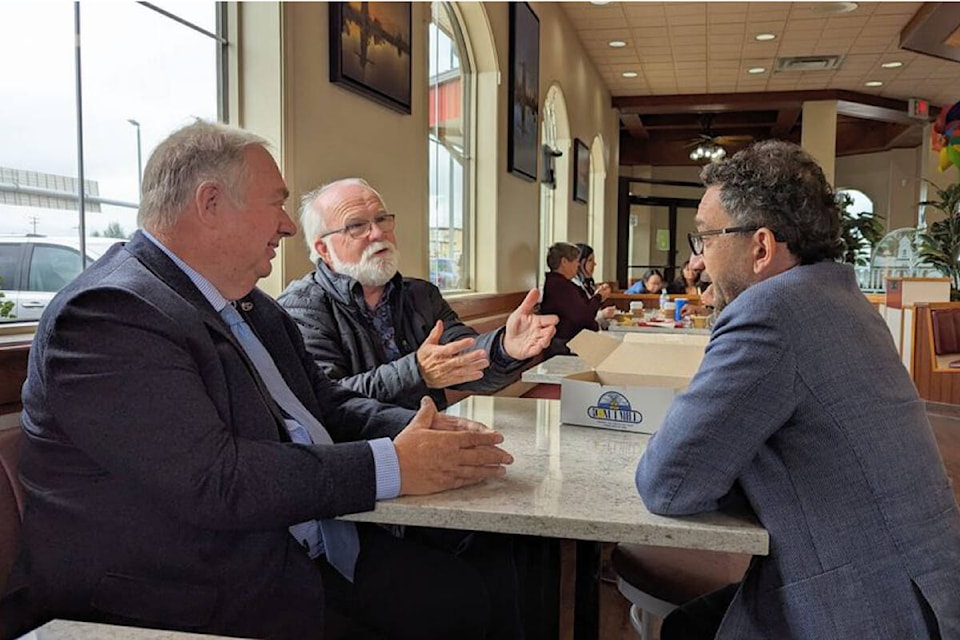Red Deer County is coming off a strong 2023 and Mayor Jim Wood expects the economic momentum to continue in 2024.
“We had really good economic growth in 2024,” said Wood. “We’ve actually seen 70 new businesses come into Red Deer County, which is really good.
“So, we’ve seen significant business growth, which I think is pretty good for the economic times we’re in.”
There were 104 new housing starts, close to the five-year average of 110 starts, and a solid result considering the impact of inflation and higher interest rates. The commercial sector saw $26.7 million worth of growth, compared with the five-year average of $24.8 million.
There have been a number of other highlights, such as the continuing success of Junction 42, the truck stop and commercial development at the Highway 42 and 2 interchange east of Penhold.
More than 200,000 truck visits were made to Junction 42 in 2023, the equivalent of a truck pulling in every two minutes and 40 seconds. Wood said there are plans to double the size of the truck parking area as soon as a provincial government financial help can be lined up to improve roads in the area, including a future roundabout to improve traffic flow.
The development got another boost when EQUS bought about seven acres of land to provide a site for a new office, shop, and yard for EQUS’ Central Service Area team, which includes about 40 employees and a fleet of vehicles. EQUS provides co-operative electricity distribution services to over 13,000 rural Alberta homes, businesses, and farms, many of them in Red Deer County
It was also a big year for Red Deer Regional Airport, which received $30 million in the spring provincial budget. The money will go towards a new access point at the north end of the airport property, a project expected to create 200 jobs. Airport Drive in Springbrook is to be extended and linked to the C&E Trail, which will provide access to 200 acres of developable airside land.
Work to widen and improve the runway and taxiways was completed this year and work begun on a $3.5 million terminal addition, a key project to help lure scheduled passenger service back to central Alberta.
Wood and Red Deer Mayor Ken Johnston were part of a trade mission to the Paris Airshow last summer to pitch the opportunities of the region to aviation-related businesses.
“We showed the potential we have for the Red Deer airport once we get all this infrastructure done. If you don’t have your shingle out nobody knows about you, so that was a huge highlight.”
The county and City of Red Deer are also expected to sign off on a new intermunicipal development plan in the coming year, that will provide a blueprint for economic growth for both municipalities.
“We’ve built extremely strong relationships with the city and all of our urban partners, towns and villages.”
When communities work together to encourage development growth it benefits all, he said.
One example of the help the county can provide was illustrated last August when county council voted to boost its financial support of a Delburne medical clinic to keep the doors open until a pair of new doctors arrive.
Council unanimously agreed to provide $4,000 a month to Delburne Medical Clinic through December. The $20,000 will help offset a monthly $12,000 operating deficit for the clinic where a single doctor is attending to the community’s health needs.
Wood said at the time that ensuring Delburne residents have access to a doctor not only helps improve community health it boosts economic development by making the village more attractive to businesses and investors and allows it to continue growing.
The county has also played a leading role in the Alternative Land Use Services (ALUS) program, which can coverup to 85 per cent of the costs for farmers and ranchers who are enhance the natural environment on their land. In addition, ALUS pays farmers and ranchers up to $75 per acre per year on acres that are producing increased environmental services.
Wood said the project has been such a success that Red Deer County now holds 20 per cent of all acres committed to ALUS across Canada.
“It’s exciting to see a project like that be so successful.”
The coming year will see a number of challenges, including lining up continued provincial funding to help rural municipalities take care of their vast infrastructure inventories.
Alberta Municipalities, which represents urban communities, and Rural Municipalities of Alberta, which is the voice of 69 rural municipalities, have called for more funding to reduce the province’s $30 billion infrastructure deficit.
Wood said he is proud of the job the county has done in maintaining services while still keeping taxes affordable for ratepayers.
